

The Blues. Blues as a genre is based on the blues form but possesses other characteristics such as lyrics, bass lines, and instruments.

Blues sub-genres include country blues, such as Delta, Piedmont and Texas blues, and urban blues styles such as Chicago and West Coast blues. World War II marked the transition from acoustic to electric blues and the progressive opening of blues music to a wider audience, especially white listeners. Country Blues. When African-American musical tastes began to change in the early 1960s, moving toward soul and rhythm and blues music, country blues found renewed popularity as "folk blues" and was sold to a primarily white, college-age audience.

Traditional artists like Big Bill Broonzy and Sonny Boy Williamson II reinvented themselves as folk blues artists, while Piedmont bluesmen like Sonny Terry and Brownie McGhee found great success on the folk festival circuit.[2] Contemporary country blues artists such as Ramon Goose have fused country blues and African styles of music to create new hybrids. See also[edit]
Rhythm & Blues. "R&B" redirects here.

For the modern style of music also called "R&B", see Contemporary R&B. Rhythm and blues, often abbreviated to R&B or RnB, is a genre of popular African-American music that originated in the 1940s.[1] The term was originally used by record companies to describe recordings marketed predominantly to urban African Americans, at a time when "urbane, rocking, jazz based music with a heavy, insistent beat" was becoming more popular.[2] In the commercial rhythm and blues music typical of the 1950s through the 1970s, the bands usually consisted of piano, one or two guitars, bass, drums, saxophone, and sometimes background vocalists.
R&B lyrical themes often encapsulate the African-American experience of pain and the quest for freedom and joy.[3] Lyrics focus heavily on the themes of triumphs and failures in terms of relationships, freedom, economics, aspirations, and sex. Soul.
British R & B. The Rolling Stones, the most commercially successful band to emerge from the movement, shown in 1965 British rhythm and blues (or R&B) was a musical movement that developed in the United Kingdom between the late 1950s and the early 1960s, and reached a peak in the mid-1960s.

It overlapped with, but was distinct from, the broader British beat and more purist British blues scenes, attempting to emulate the music of African American blues and rock and roll pioneers, such as Muddy Waters and Howlin' Wolf, Chuck Berry and Bo Diddley. Jump blues. Origins[edit] Louis Jordan in 1946 Jump evolved from big bands such as those of Lionel Hampton and Lucky Millinder.
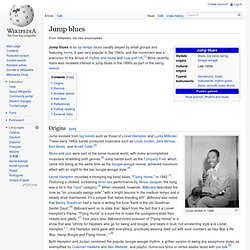
These early 1940s bands produced musicians such as Louis Jordan, Jack McVea, Earl Bostic, and Arnett Cobb.[2] Blues and jazz were part of the same musical world, with many accomplished musicians straddling both genres.[3] Jump bands such as the Tympany Five, which came into being at the same time as the boogie-woogie revival, achieved maximum effect with an eight-to-the-bar boogie-woogie style.[4] Both Hampton and Jordan combined the popular boogie-woogie rhythm, a grittier version of swing-era saxophone styles as exemplified by Coleman Hawkins and Ben Webster, and playful, humorous lyrics or verbal asides laced with jive talk.[5] As this urban, jazz-based music became more popular, both bluesmen and jazz musicians who wanted to "play for the people" began favoring a heavy, insistent beat.
West Coast Blues. The West Coast blues is a type of blues music characterized by jazz and jump blues influences, strong piano-dominated sounds and jazzy guitar solos, which originated from Texas blues players relocated to California in the 1940s.[1] West Coast blues also features smooth, honey-toned vocals, frequently crossing into urban blues territory.
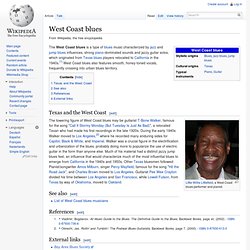
Texas and the West Coast[edit] See also[edit] List of West Coast blues musicians References[edit] Jump up ^ Vladimir, Bogdanov. Boogie-woogie. Boogie-woogie is an African American style of piano-based blues that became popular in the late 1930s and early '40s, but originated much earlier, and was extended from piano, to three pianos at once, guitar, big band, and country and western music, and even gospel.
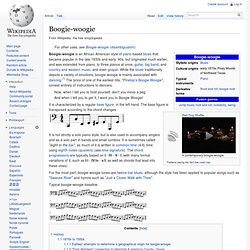
While the blues traditionally depicts a variety of emotions, boogie-woogie is mainly associated with dancing.[1] The lyrics of one of the earliest hits, "Pinetop's Boogie Woogie", consist entirely of instructions to dancers: Now, when I tell you to hold yourself, don't you move a peg. And when I tell you to get it, I want you to Boogie Woogie! It is characterized by a regular bass figure, in the left hand. The bass figure is transposed according to the chord changes.
Rock & roll. Rock and roll (often written as rock & roll or rock 'n' roll) is a genre of popular music that originated and evolved in the United States during the late 1940s and early 1950s,[1][2] primarily from a combination of African-American genres such as blues, jump blues, jazz, and gospel music,[3] together with Western swing and country music.[4] Though elements of rock and roll can be heard in blues records from the 1920s[5] and in country records of the 1930s,[4] the genre did not acquire its name until the 1950s.[6][7] The term "rock and roll" now has at least two different meanings, both in common usage: referring to the first wave of music that originated in the US in the 1950s and would later develop into the more encompassing international style known as "rock music", and as a term simply synonymous with the rock music and culture in the broad sense.[8] For the purpose of differentiation, this article deals with the first definition.
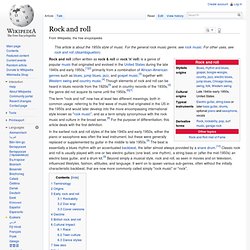
Terminology[edit] Origins[edit] Garage Rock. Garage rock is a raw form of rock and roll that was first popular in the United States and Canada from about 1963 to 1967.

Its name derives from the perception that many often rehearsed in a family garage. In the early 1970s, some critics referred to the style as punk rock, the first form of music to bear this description; although it is sometimes called garage punk, protopunk, or 1960s punk, the style has predominantly been referred to as garage rock. Characteristics[edit] The term garage rock comes from the perception that many such performers were young and amateurish, and often rehearsed in a family garage.[1] Some bands were made up of middle-class teenagers from the suburbs, but some were from rural or urban areas, while others were composed of professional musicians in their twenties.[2]
Punk. Punk rock (or simply punk) is a rock music genre that developed between 1974 and 1976 in the United States, United Kingdom, and Australia.
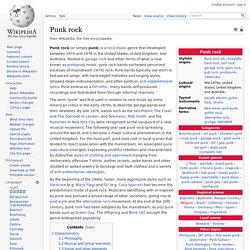
Rooted in garage rock and other forms of what is now known as protopunk music, punk rock bands eschewed perceived excesses of mainstream 1970s rock. Punk bands typically use short or fast-paced songs, with hard-edged melodies and singing styles, stripped-down instrumentation, and often political, anti-establishment lyrics. Post-Punk. 1977–79[edit] 1980s[edit] In 1980, critic Greil Marcus characterised "Britain's postpunk pop avant-garde" – in a Rolling Stone article (referring to bands including Gang of Four, The Raincoats and Essential Logic) – as "sparked by a tension, humour and sense of paradox plainly unique in present day pop music.
" In 1982, The Smiths formed[6] and "post-punk" could then be, arguably, said to encompass a diversity of groups and musicians, as the band have been noted to have little in common with the punk genre.[7] Influence[edit] Post-Punk Revival. Definitions and characteristics[edit] History[edit] Genres, scenes and origins[edit] New Wave. New wave differs from other movements with ties to first-wave punk as it displays characteristics common to pop music, rather than the more "arty" post-punk,[14] though it incorporates much of the original punk rock sound and ethos[6][15] while arguably exhibiting greater complexity in both music and lyrics.
Common characteristics of new wave music, aside from its punk influences, include the use of synthesizers and electronic productions, the importance of styling and the arts, as well as a great amount of diversity.[14] New wave is seen as one of the definitive genres of the 1980s;[16] the genre became a fixture on MTV,[14] and the popularity of several new wave artists has been partially attributed to the exposure that was given to them by the channel.
In the mid-1980s, differences between new wave and other music genres began to blur.[17][14] New wave has enjoyed resurgences since the 1990s, after a rising "nostalgia" for several new wave-influenced artists. Duran Duran in 1981. Hardcore Punk. Hardcore sprouted underground scenes across the United States in the early 1980s particularly in Washington, D.C., California, New York, New Jersey, and Boston—as well as in Australia, Canada and the United Kingdom. Musical characteristics[edit] Politics[edit] Punk fans burning a United States flag in the 1980s. Hardcore dancing[edit]
Alternative Rock. Alternative rock (also called alternative music, alt-rock or simply alternative) is a style of rock music that emerged from the independent music underground of the 1980s and became widely popular in the 1990s. Pop Punk. Pop-influenced punk rock emerged in the mid 1970s in multiple countries, and was stylistically similar to power pop. By the early 1980s, several bands merged hardcore punk with pop music to create a new, faster pop punk sound. Pop punk particularly thrived in California, where independent record labels adopted a do it yourself (DIY) approach to releasing music. In the mid 1990s, a few pop punk bands sold millions of records and received extensive radio and television airplay. A second wave of pop punk in the late 1990s represented the genre's mainstream peak, although some pop punk bands scored successful album chartings in the 2000s. The genre generally waned in popularity by the late 2000s, although it still retains a smaller but dedicated following.
Protopunk. Doo-Wop.
Rock. Beat Music. Surf Music. Surf music is a genre of popular music associated with surf culture, particularly as found in Orange County and other areas of Southern California. It was especially popular from 1961 to 1966, has subsequently been revived and was highly influential on subsequent rock music.[7] It has two major forms: largely instrumental surf rock, with an electric guitar or saxophone playing the main melody, largely pioneered by Dick Dale and the Del-Tones, and vocal surf pop, including both surf ballads and dance music, often with strong harmonies that are most associated with the Beach Boys. Instrumental surf rock[edit] 1963 Performance Flyer Form[edit] Surf music began in the early 1960s as instrumental dance music, almost always in straight 4/4 (or common) time, with a medium to fast tempo.